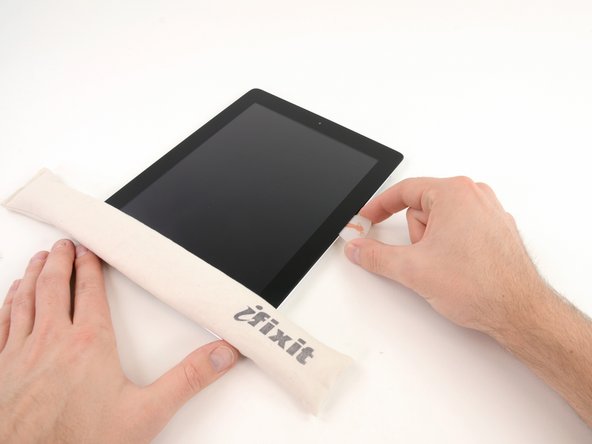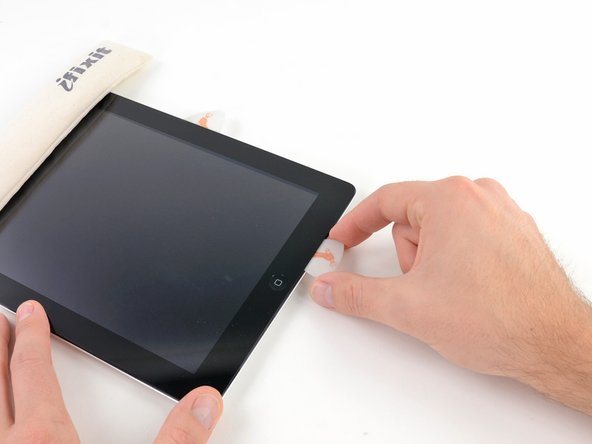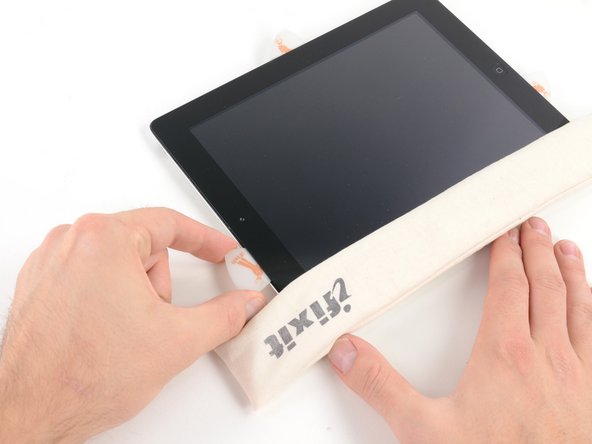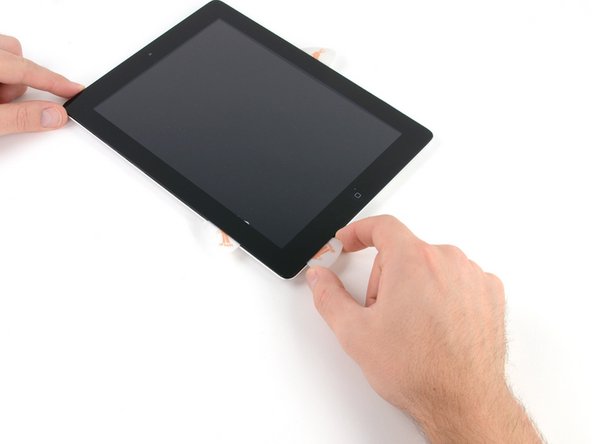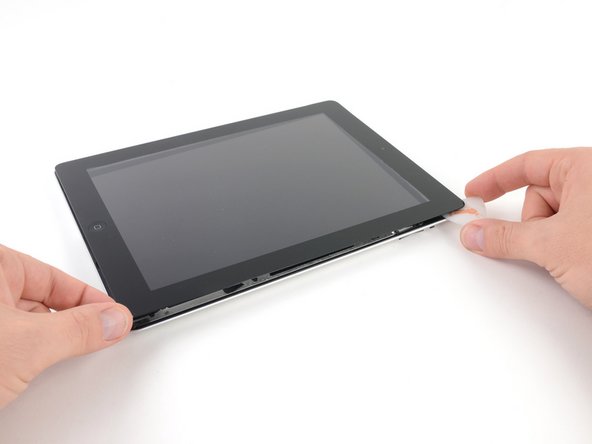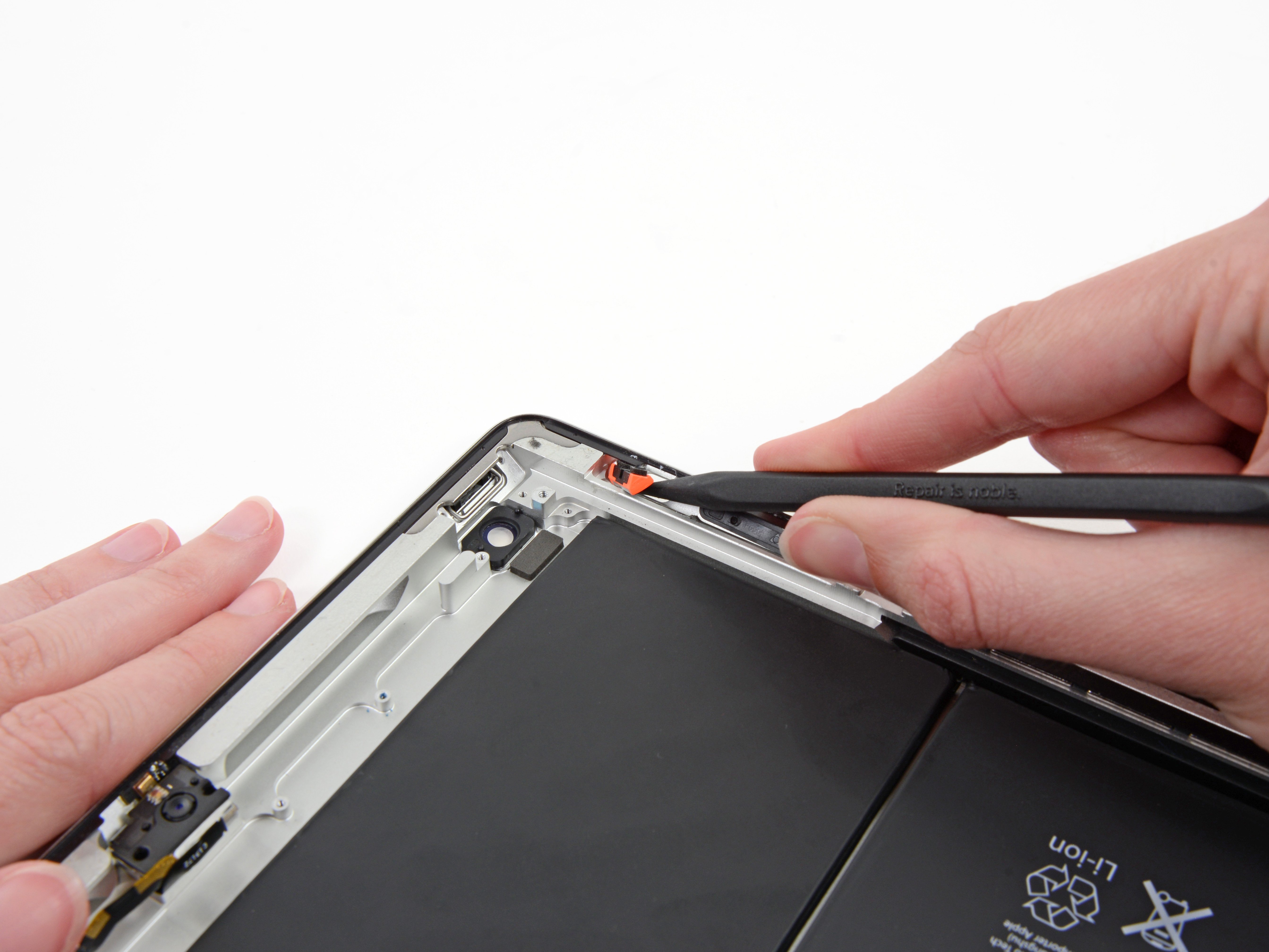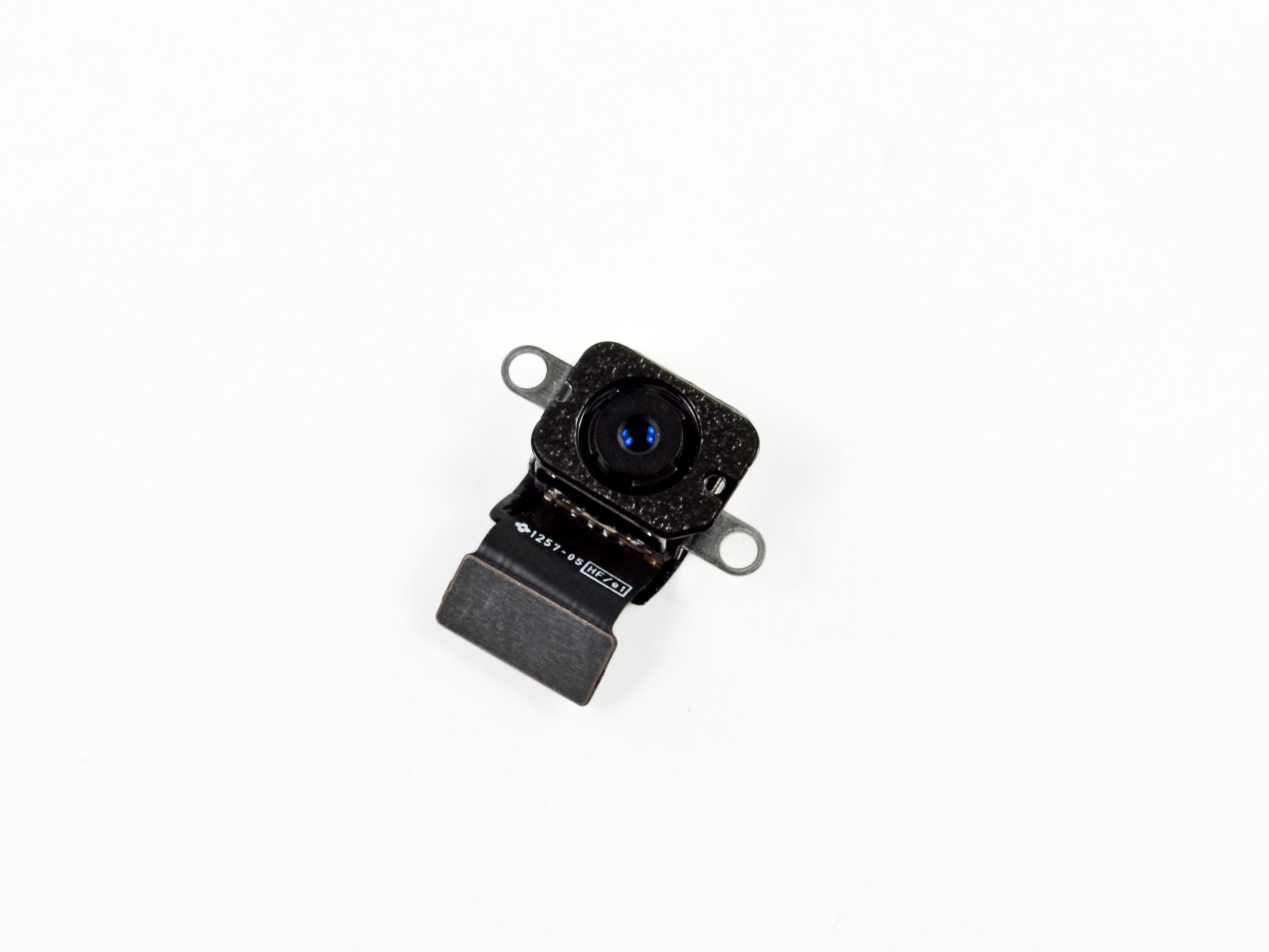iPad 4 Wi-Fi Home Button Assembly Replacement
Duration: 45 minutes
Steps: 45 Steps
Follow this guide to swap out your home button assembly like a pro.
Step 1
For carousel microwaves: Ensure the plate spins with ease. If your iOpener gets jammed, it might overheat and start burning. Keep it moving smoothly to avoid any heat trouble!
It's a good idea to give your microwave a quick clean before diving in, as any leftover mess on the bottom could get cozy with the iOpener.
- Pop the iOpener right in the center of your microwave.
Tools Used
Step 2
Remember, keep the iOpener at a safe temperature during the repair. Overheating could cause it to pop, and we definitely don't want that! Don't heat it above 100˚C (212˚F).
If the iOpener looks like it's puffing up, definitely avoid touching it.
If the middle of the iOpener is still too hot to touch, just give it a moment to cool down before reheating. A properly heated iOpener should stay nice and warm for up to 10 minutes.
Microwaves vary, so you might need to adjust the time a little. You'll know the iOpener is good to go when it's almost too hot to touch, but not quite!
- Give your iOpener a warm-up in the microwave for thirty seconds. It's like a spa day for your repair tool!
- As you work through the repair, keep that iOpener cozy by popping it back in the microwave for another thirty seconds whenever it starts to cool down. Stay toasty!
Tools Used
Step 3
The iOpener can get pretty hot, so handle it with care. If it's too much, an oven mitt will be your best friend.
- Take the iOpener out of the microwave, but grab it by one of the flat ends—avoid the hot middle, it’s a bit too toasty!
Tools Used
Step 4
Heads up! The iOpener gets super hot, so make sure to grab it only by the end tabs to keep your fingers safe.
No microwave? No problem! Simply heat your iOpener by submerging it in boiling water. It’s an easy workaround to get things warmed up for the next step.
- Grab a pot or pan and fill it with enough water to give your iOpener a nice warm bath.
- Turn up the heat and bring that water to a rolling boil. Once it's bubbling away, go ahead and switch off the heat.
- Carefully drop the iOpener into the hot water for about 2-3 minutes. Make sure it's fully submerged so it can soak up all that heat goodness.
- Now, use some tongs to fish out your heated iOpener from the water. Safety first!
- Give the iOpener a good towel dry – we don’t want any water left hanging around.
- And voilà! Your iOpener is all set and ready to go! If it needs a little more warmth later, just repeat the process: heat the water to a boil, turn off the heat, and let the iOpener soak for another 2-3 minutes.
Tools Used
Step 5
Put on those safety glasses to keep your eyes safe, and make sure you don't accidentally bump that LCD screen – it's more fragile than it looks!
This step will help keep those pesky glass shards under control and maintain the structure of your device while you're carefully prying and lifting the display.
- If your display glass is cracked, help prevent further damage and keep things safe by taping over the cracks. Trust us, it'll make your life easier as you go.
- Start by laying down some overlapping strips of clear packing tape over the iPad’s display. Cover the whole screen, making sure it’s well secured.
- Now, take your time and follow the guide as best as you can. But be warned, once that glass is cracked, it’s probably going to keep breaking. You might need a metal prying tool to carefully scoop out the shards.
Step 6
Just a heads up! You might be dealing with some broken glass during this process, so we highly suggest rocking a pair of safety glasses to keep those pesky shards at bay. Better safe than sorry, right?
- Place the iOpener flat against the right edge of your iPad, ensuring it's nice and snug for optimal warmth. Let's get that contact going!
- Now, let the iOpener chill on the iPad for about 90 seconds. This little wait is key before you dive into opening the front panel.
Tools Used
Step 7
You might need to give a little nudge to slide that wedged tip of the opening tool between the glass and plastic. Take your time and be gentle—wiggle that plastic opening tool back and forth as needed. You've got this!
- Spot a tiny gap in the iPad's adhesive ring at the upper right corner, about 2.0 inches (~5 cm) down from the top. We're going to take advantage of this little opening.
- Line up your tool with the mute button. Gently slip the tip of a plastic opening tool into the gap between the front glass and plastic bezel—just enough to nudge the crack open a bit.
Step 8
- Carefully slide your tool right where the magic happens—between the plastic display bezel and the front glass panel. You've got this!
Step 9
- Place the tip of your plastic opening tool between the front glass and the plastic bezel, then gently slide a plastic pick into the gap, right alongside the tool. Keep it steady and make sure you're in the right spot – you've got this!
Step 10
- Gently pull out the plastic opening tool from the iPad, then slide the opening pick a bit deeper under the front glass—aim for about half an inch in. Keep it smooth and steady!
Step 11
- As you tackle that sticky adhesive on the right side of the iPad, give your iOpener another round of heat and pop it back on the bottom edge of the iPad. You've got this!
Tools Used
Step 12
This adhesive is pretty stubborn, so you might need to apply a little muscle. Take it slow and steady, and you'll get there!
If the tip of your trusty opening pick is peeking out from under the front glass, gently pull it out a smidge. Don’t worry, using the pick this deep won’t cause any harm, but it might leave a little adhesive residue on that lovely LCD.
- As the iOpener works its magic on the bottom edge, start loosening up that adhesive on the right side of your iPad.
- Gently slide the opening pick along the iPad's edge, freeing up the adhesive with each move.
Tools Used
Step 13
As you release the adhesive, you might need to pop the heated iOpener back onto the right edge of the iPad. How long it’s been cooling off while you’ve been busy will decide if that’s necessary or not.
- If your opening pick gets stuck in the adhesive, no worries! Just 'roll' the pick gently along the edge of the iPad to keep loosening that sticky stuff.
Tools Used
Step 14
- Before pulling out the first opening pick from the bottom corner of the iPad, slide a second pick under the right edge of the front glass to keep that sticky adhesive from sticking back together.
- Heat up the iOpener again, then shift it over to the top edge of the iPad to keep things nice and pliable.
Tools Used
Step 15
The Wi-Fi antenna is screwed and connected by a cable at the bottom right edge of the iPad's rear case. Because of how the antenna sits, take extra care during this step to avoid causing any permanent damage to it.
- Heads up—these next steps need some serious care and attention.
- You’ll need to gently free the adhesive holding the antenna to the front panel without harming the fragile parts connecting the antenna to the bottom of the iPad. Take it slow and follow along carefully.
Step 16
Keep the pick at the bottom right corner—sliding it any further might mess up the Wi-Fi antenna, and we definitely don’t want that!
- Gently glide the opening pick around the bottom right corner of your iPad to free it from the adhesive's grip. You've got this!
Step 17
Be careful as you glide the opening pick along the bottom right edge of the front panel. The Wi-Fi antenna is hanging out nearby and can easily get damaged if the adhesive isn't released just right. Take it slow, and you're good to go!
Keep the pick tucked just a smidge under the front glass—about 1/8" (3 mm) of the tip should stay put—don’t pull it out all the way!
- Gently glide the tip of your opening pick along the bottom edge of the iPad, freeing up that sticky adhesive holding the Wi-Fi antenna in place. You've got this!
Step 18
- After you pass the Wi-Fi antenna (about 3" (75 mm) from the right edge, right by the home button), slide the opening pick all the way in again.
- Gently slide the pick to the right to loosen the adhesive holding the Wi-Fi antenna to the front glass.
- The antenna is screwed and connected with a cable at the bottom of the iPad. This step frees the antenna from the front panel so you can remove the panel without causing any damage.
Step 19
Don't overdo it with the iOpener heat! Keep it to just one minute at a time, and make sure to let it cool down for at least two minutes before you reheat. Patience is key!
If the adhesive along the bottom edge has cooled down too much, just give the iOpener another quick warm-up to soften it back up where you’re working.
- Keep working that adhesive loose along the bottom of your iPad! Gently pull the opening pick out just enough to navigate around the home button. Once you’re past the home button, reinsert it to about half an inch (10 mm) deep. You've got this!
Tools Used
Step 20
For iPad 4 models, slide the pick in no deeper than 1/2 inch (10 mm) here to keep that home button ribbon cable safe and sound.
- Gently peel away the adhesive along the bottom edge of the iPad, making sure to stay steady and smooth.
- Keep that opening pick snug under the front glass near the home button—just a little nudge to keep things in place.
Step 21
- Give your iOpener a quick spin in the microwave and then place it on the left edge of your iPad. This will help warm up the adhesive in that area, making things a lot easier for you.
Tools Used
Step 22
If your iOpener has cooled off a bit too much, just swap it out along the top edge and keep going. No worries! If it’s still not warm enough, give it a quick reheat and get back to work.
- Gently slide the opening pick along the top edge of the iPad, easing it out just enough to get around the front-facing camera bracket.
- Heads up: the adhesive here is super stubborn and thick, so you might need to apply a bit of muscle. Take it slow and steady to avoid any slips or scratches on you or your iPad.
- If the pick starts to get stuck in the gooey adhesive, try "rolling" it like in step 9 to keep things moving smoothly.
Tools Used
Step 23
If the adhesive is feeling nice and toasty, go ahead and take that iOpener off the iPad for some extra ease. But if it’s still holding on tight, give the iOpener another quick heat-up and rest it on the left edge while you tackle your task.
- Gently peel off the adhesive along the top edge of the iPad, then carefully slide your opening pick around the top left corner. Nice and steady—you're almost there!
Tools Used
Step 24
The digitizer cable hides out about 2" (50 mm) up from the bottom of your iPad. When your pick hits around 2.25" (60 mm), it's time to pause and check your progress!
- Gently slide the opening pick along the left edge of the iPad to loosen the adhesive as you go. Heads up—the adhesive here is pretty thin because the digitizer runs along the entire left side. Keep that pick shallow (no more than about 10 mm or half an inch) to avoid any accidental damage to the digitizer.
Step 25
Be super careful down there! The bottom of that digitizer cable is just about an inch (25 mm) away from the edge of your iPad. Take your time and tread lightly—let's avoid cutting that cable, okay? You've got this!
- Carefully slide the opening pick that’s still tucked under the bottom edge of your iPad to gently loosen the adhesive in the bottom left corner.
Step 26
It looks like some of that sticky stuff around the edge of your iPad might have reattached itself. No worries! Just slide a pick underneath the edge where the front glass is still hanging on and gently 'slice' through that adhesive.
- Grab your trusty opening pick and gently pop up the bottom right corner of the iPad. Once it's lifted, use your fingers to hold it in place. You're doing great!
Step 27
Watch out for any stubborn adhesive still hanging around! Grab an opening pick and gently slice through any sticky stuff that might be keeping the front panel in place.
- Grab the iPad by its top and bottom right corners and gently peel the front glass away from the device.
- When putting everything back together, give the LCD a good once-over with a microfiber cloth and a blast of compressed air to clear away any dust or smudges before snapping the glass back on.
Step 28
The bottom left screw is hiding behind the home button ribbon cable connector. Gently nudge that cable aside to free the bottom left screw. You've got this!
- Unscrew those four little 2 mm Phillips #00 screws that are holding the LCD snugly to the aluminum frame. You've got this!
Step 29
Handle the LCD with care—its ribbon cable is delicate and might snap if you bend it too much. Keep it cool and steady!
- Grab a plastic opening tool or a spudger and gently lift the right edge of the LCD out of the iPad.
- Now, carefully rotate the LCD along its left edge and lay it down on the front glass panel like you're setting it on a cozy bed.
Tools Used
Step 30
- Grab your trusty spudger and carefully lift up the tape that’s hiding the LCD ribbon cable connector. A little nudge with the tip should do the trick!
Tools Used
Step 31
- Lift the little retaining flap on the LCD ribbon cable ZIF connector with care. You've got this!
- With a gentle touch, either use your fingers or a pair of tweezers to wiggle the LCD ribbon cable free from its cozy spot on the logic board.
Tools Used
Step 32
- Gently lift the LCD off the front panel without touching its screen. It’s like peeling off a sticker—smooth and steady!
Step 33
If you see it, gently peel off that piece of electrical tape covering the Wi-Fi antenna, speaker cable, and home button ribbon cable. It’s like unveiling a hidden treasure!
Step 34
- Gently lift the retaining flap on the home button ribbon cable ZIF connector. Just a little nudge is all it takes!
Step 35
- Grab a pair of tweezers and gently pull that home button ribbon cable straight out from its snug spot on the logic board. A steady hand and a little patience go a long way here!
Tools Used
Step 36
- Gently lift the home button ribbon cable out of its cozy nook in the back case.
Step 37
- Grab a pair of tweezers and gently peel back the tape that's holding the digitizer ribbon cable onto the logic board. A little tug, and you're good to go!
Tools Used
Step 38
- Gently lift the little flap on both digitizer ribbon cable ZIF connectors to unlock them.
Step 39
- Gently wiggle the flat end of your spudger under the digitizer ribbon cable to loosen up that stubborn adhesive.
- Carefully pull the digitizer ribbon cable straight out from its connectors on the logic board—no sideways moves!
Tools Used
Step 40
- Gently lift up the digitizer ribbon cable, then slide the flat end of a spudger underneath to carefully break loose the adhesive holding the cable to the back aluminum case.
Tools Used
Step 41
- Gently wiggle the digitizer ribbon cable free from its snug spot in the aluminum frame using your fingers.
- Carefully lift the front panel away from the iPad.
Step 42
Heads up! Don't let the iOpener get too toasty during your repair. Give it a cool two-minute breather before heating it up again to keep things safe and smooth.
The home button assembly is stuck on the front panel with some adhesive. To make things easier, try using an iOpener to soften the adhesive before you remove it.
- Pop the iOpener in the microwave for a minute on high heat (or just thirty seconds if you've got the newer gel-filled iOpener).
- Gently place the iOpener over the home button, right on the front edge of your display.
Tools Used
Step 43
- Gently detach the home button ribbon cable from the front panel, taking care to avoid any unnecessary tugs. You've got this!
Step 44
- Slide that plastic opening tool under the right side of the home button assembly and give it a gentle nudge upwards to break free that pesky adhesive holding it down.
- Now, just like before, slide the tool over to the left side and release the adhesive there too.
- With that done, carefully lift the home button mount off the front panel like a pro!
Step 45
- Gently slide the plastic opening tool under the edge of the home button mounting bracket.
- Carefully glide the tool along the retaining spring bracket to free the adhesive.
- Lift the home button along with its mounting bracket away from the front panel.
























